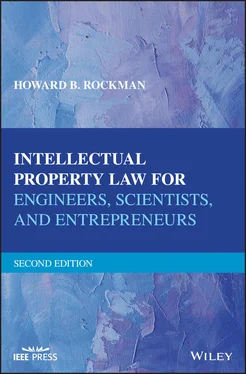9.4 PROVISIONAL PATENT APPLICATIONS
The U.S. Patent Laws were amended several years ago to allow the filing of provisional, or partially complete, patent applications to secure to the inventor a filing date prior to the time a complete patent application could be prepared, and requiring that the complete application be filed within one year from filing the provisional patent application. The purpose of the change in the law was to allow an inventor to establish a priority date as to his or her invention, without depending upon the workload, or the speed of preparation, of a patent attorney.
A provisional patent application can be filed without any claims, without any declaration of inventorship by the inventor or inventors, and without a disclosure of prior art know by the inventor. The provisional application is basically a “shorthand” way of filing your novel technical information with the USPTO, indicating that within one year you expect to file a regular, non‐provisional patent application covering the same technology. The purpose of the provisional application is to “save the date.” However, the provisional patent application cannot be too threadbare, since 35 U.S.C. §112 requires that the completeness of the invention described in a provisional application must also meet the standard of completeness of a regular, non‐provisional application.
To place a provisional patent application on file with the USPTO, the inventor and/or his or her attorney file, among other things, a cover sheet that identifies the application as a provisional application, the identity of all the inventors usually in the form of an unsigned declaration setting forth the names and addresses of the inventors, and materials, usually furnished by the inventor, consisting of a description and drawings of the invention, which need not necessarily be in the form of a normal patent application. The description and the drawings must be sufficient to allow the Patent Examiner and the public to fully understand the invention, since within one year a regular patent application will be filed, and the provisional application will become part of the prosecution history available to the public upon issuance of the patent from the regular patent application. The provisional application material must include all of the technology you include in the claims of your regular, non‐provisional patent application when the latter is filed.
I challenge the definition of a provisional patent application as being an “application,” because the rules clearly state that no provisional application will be examined for patentability, nor will it ever be issued as a U.S. patent. It is more of a “statement” that provides an early priority date if a regular, non‐provisional patent application is subsequently filed within one year. Also, the priority period provided by the provisional application is not included in the 20 year term of enforceability of the patent counting from the date of filing the regular application. Note further that provisional patent applications cannot be filed for design inventions.
The term “Patent Pending” may be used in connection with inventions that are the subject of provisional patent applications. Since 12 months after the filing of the provisional application the application and your priority date automatically lapse if a non‐provisional application is not filed, it is important to file the regular non‐provisional patent application within that 12‐month period or you will lose your priority filing date. It is possible to file a second provisional patent application describing the same invention as the first one, but the second provisional application cannot claim the priority date of the first provisional patent application.
9.5 REGULAR, NON‐PROVISIONAL PATENT APPLICATION; NO NEW MATTER
As you probably have discerned by now, a patent application is a series of documents filed with the USPTO with the objective of ensuring that the application proceeds successfully through an examination process and ultimately is issued as a patent. The most important thing to keep in mind when reviewing your application prior to filing, and in furnishing your patent attorney with information about your invention, is that once the application is filed with the USPTO, amendments can be made to the application during the examination process only within the framework of the material in the application as originally filed. There is a very strict rule that prohibits the introduction of “new matter” into any pending patent application. New matter is defined as any subject matter that is not described, shown‚ or suggested in the four corners of the patent application as first filed. Thus, by way of example, if the inventor develops a new embodiment or an additional improvement to the invention covered by the filed patent application, that new material covering the new embodiment or additional improvement cannot be placed in the pending patent application. A new patent application, designated a “continuation‐in‐part application,” which will be described in Chapter 11, can be filed to cover the new material related to the invention. As such, the inventor will ultimately end up with two or possibly more patents. Therefore, it is important when assisting the patent attorney preparing your patent application, that all of the subject matter relating to your invention, including all new material, improvements‚ and new advantages, be disclosed to him or her for inclusion in the originally filed application, to the extent possible.
It is also important that you provide the patent attorney with full knowledge of a completely conceived invention, the best mode contemplated for practicing the invention, and sufficient information to enable one skilled in the art to practice the invention without undue experimentation upon expiration of the patent. As stated previously, it is also important to provide your patent attorney with all prior art of which you are aware. The attorney may introduce some of the prior art in the body of the patent application itself in describing prior attempts at solutions to the same problem which your invention is directed toward solving.
9.6 CONTENT OF A REGULAR NON‐PROVISIONAL PATENT APPLICATION
When working with your patent attorney, you will be asked to assist in the preparation of the application by initially furnishing all information relating to the structure, operation‚ and advantages of your invention. There are many ways of describing an invention; however, over the years and aided by court decisions as to what the content of a patent application should be, and having the USPTO codify rules as to what they expect in a patent application, a somewhat definitive content of a patent application has developed over the last 225 years or so of the U.S. Patent System. As a result, most patent attorneys today use a similar “format” in preparing their patent applications. While this format may vary from case to case, the following sets forth the most acceptable way of presenting your material to the Patent Examiner in the judgment of the author.
9.6.1 Title of the Invention
The title of the invention should broadly describe the purpose of the invention, or the structure of the invention. Thus, the title could be “Apparatus for Preheating Engine Blocks” or “Process for Detasseling Corn,” or something similar. Note that the USPTO website lists patents owned by inventors, corporations‚ and other entities by their title and patent number, which enables easier searching for relevant patents if the title is descriptive of the disclosed invention to a certain degree.
9.6.2 Cross‐Reference to Other Applications
In many instances, your patent application will be a continuation, continuation‐in‐ part‚ or division of a previously filed related patent application, discussed in Chapter 11, or claiming priority to previously filed provisional patent application. To properly establish the chain of the parent patent application(s) in your present application, it is necessary to place a statement in your current patent application referring to these earlier applications of which the present application is a family member. This sets forth the continuity of these patent applications, and allows later filed patent applications to rely upon the earlier filing date of the parent application as a priority filing date for commonly disclosed subject matter.
Читать дальше












